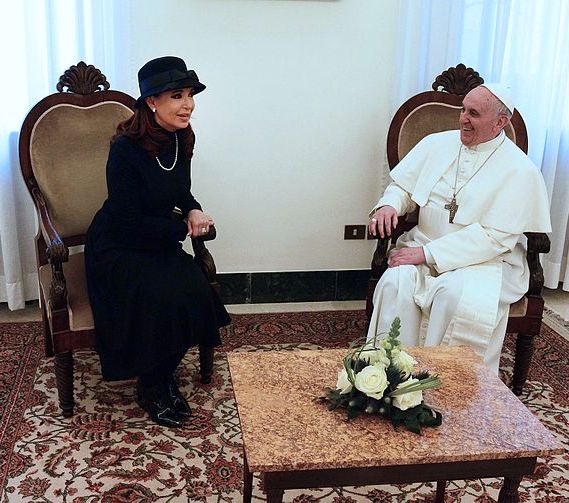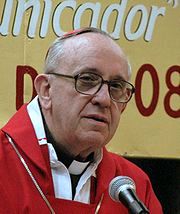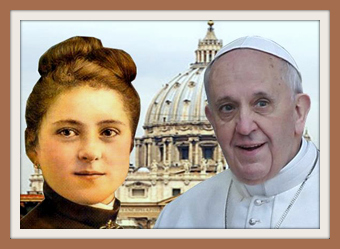Saint Therese of the Child Jesus
of the Holy Face
Entries in Stefania Falasca (2)
"A White Rose from Saint Therese" by Stefania Falasca. Pope Francis's devotion to St. Therese. March 24, 2013
A White Rose from Saint Therese
Mary and Joseph, but also the Carmelite of Lisieux: the Pope is very tied to the master/teacher of child-like spirituality: “Whenever I have a problem—he explained—I put confide it to her. I don’t ask that she solve it for me, only that she take it into her hands and help me.”
The devotion and spiritual bond of Bergoglio for the “Little Flower of Jesus.” “This is what I call her when I ask for her help.”
By Stefania Falasca
Whoever has had the opportunity to get to know and be friends with Cardinal Jorge Maria Bergoglio knows that it was his custom to include, even in a short note, an ancient image of Mary venerated in Bavaria, at Augsburg, in the Church of St. Peter, called “She who unties knots.” To this he always added a little holy card of Saint Joseph and another of the Carmelite saint and Doctor of the Church, Therese of Lisieux—almost to emphasize, by his deeply meaningful personal choice, the spiritual bond that unites him to them.
 Christina Kirchner, president of Argentina, with Pope Francis and St. Therese's white roses
Christina Kirchner, president of Argentina, with Pope Francis and St. Therese's white roses
In recent days we have seen Pope Francis refer, by his gestures and teaching, to Mary and Saint Joseph, in profound and discreet ways. Neither has the gift to Argentine President Christine Kirchner of the Aparecida Statement (the concluding text of the fifth conference of all the Bishops of Latin America), along with a white rose, gone without notice. A sensitive gesture—the gift of a rose—that the President herself did not fail to call “intimate,” like “a greeting from Saint Therese, to whom Pope Francis directs his prayers.”
But why and from where does this preference of Pope Francis for Therese come? I asked myself this even at Aparecida in 2007. I had briefly met Cardinal Bergoglio in the portico of the Brazilian Marian shrine between one meeting or another of the preparatory commission for the final statement.
He had told me that wherever the bishops gathered to work together, they were so aware of the prayers and singing of the faithful and that this gave them a lively sense of belonging and closeness to the people, to a Church that walks with its people . . . I have to admit that what came across to me in that moment in his “spiritual” tone was patronizing and vague, rather than a strong and challenging statement to be noticed.
But the Cardinal had continued: “We shouldn’t be afraid to rely solely on the tenderness of God, as Therese of Lisieux did, who is precisely for this a favored daughter of Our Lady and a great missionary saint.”
It was an understanding of the Church and her mission along the lines of the “little way” opened by the teacher of spiritual child-like spirituality, which we see today woven all through the first acts of the pontificate of Pope Francis.
I later learned that when he came to Rome to deal with this or that ministerial obligation, the cardinal always went to pray at a statue of Therese of the Child Jesus in a little Franciscan church in the Borgo near the Tiber. And also how much his devotion to the Patron of the Missions was known by his priests in Buenos Aires, especially in the poor areas of the Argentine capital.  Cardinal Bergoglio
Cardinal Bergoglio
But let’s now get back to the roses. Cardinal Bergoglio had returned to Rome at the end of 2007 for the Consistory. And with him he brought back St. Theresa: “When I have a problem—he told us—I confide it to her. I don’t ask that she solve it for me, only that she take it in her hands and help me; as a sign, I almost always receive a rose.” He then related how one time, when he had to make an important decision about a complex matter, he left it in her hands. Sometime later, an unknown woman placed three white roses at the doorstep of the sacristy.
“It was a Jesuit—he explained—Fr. Putigan, who in 1925 began to spread this personal prayer of intercession,” and he repeated a section of the “Prayer to ask for a rose”: “Little Flower of Jesus, ask God today that he will grant the petition that I now place with confidence into your hands.”
One perceives in his way of speaking a shyness combined with simplicity, a sincere confidence, so much so that I was moved to imitate him. In a particular situation, taking him as an example, I prayed like him to St. Therese, but to my great regret I received no rose. At my first opportunity I briefly told him about it over the telephone. I told him, “Father, remember that prayer about roses . . . look, nothing…no roses for me. But listen, I’m not surprised; I can understand it; these things work with holy people like you, who have their lives in order, and I am certainly not what one might call a virtuous flower.”
First silence on the other end, then his calm voice replied, blowing me away another time: “This means that she will answer you with a greater grace than the one you asked for.” It really turned out that way.

translated from "Una rosa bianca da Santa Teresa" by Stefania Falasca in the March 24, 2013 issue of l'Avvenire. English translation copyright Maureen O'Riordan 2013.
Pope Francis and Saint Thérèse of Lisieux: “To depend solely on the tenderness of God”
Pope Francis and Saint Thérèse of Lisieux:
“To depend solely on the tenderness of God”
An excerpt and photo courtesy of the Sanctuaire de Lisieux from the story “Una rosa bianca da Santa Teresita” by Stefania Falasca, in the March 24, 2013 issue of Avvenire. Translated from the French.
“Do not be afraid to depend solely on the tenderness of God
as Saint Thérèse of Lisieux did.”

When Cardinal Bergoglio wrote a letter, he enclosed an image of St. Therese
Anyone who had the opportunity to be in contact with and establish a friendship with Cardinal Jorge Mario Bergoglio knows that he had the habit of enclosing in his letters, no matter how short, . . . a picture of the Carmelite saint, Thérèse of Lisieux. In this way he wanted to emphasize his personal choice, full of meaning, of the spiritual bond that united them.
At the beginning of his pontificate, we saw Pope Francis give the President of Argentina, Cristina Kirchner, a white rose, a sign of the “little Thérèse” to whom he prays especially.
But why and from where did this fondness for Thérèse begin?
I was wondering about this very thing in Aparecida in 2007.1 At the time, I met Cardinal Bergoglio briefly in front of the Brazilian Marian Shrine between meetings of the Preparatory Committee of the final document . . .
He said to me, “Do not be afraid to depend solely on the tenderness of God as Saint Thérèse of Lisieux did, who, for this reason, is a beloved daughter of the Blessed Mother and a great missionary saint.”
It was [an invitation] to see the Church and her mission [as being] on the road of the “little way” given by his teacher of Spiritual Childhood, the way on which Pope Francis is beginning his Pontificate.
I learned a little later that, when he came to Rome, in between meetings Father would go to pray in front of a statue of Saint Thérèse of the Child Jesus in a little church run by the Franciscans in Borgo, near the Tiber.
In Buenos Aires also, his veneration of the Patroness of the Missions2 was well known by his priests, and it was spread particularly in the “villa miserias” [shantytowns, slums] of the Argentine capital [Buenos Aires].
Cardinal Bergoglio speaks in Rome about his prayer to St. Therese
But now let’s get to the roses. Father Bergoglio had returned to Rome at the end of 2007 for the Consistory. And with him, the figure of little Thérèse reappeared: ”When I have a problem,” he said to us, “I entrust it to her. I don’t ask her to resolve it, but to take it into her hands and help me; almost always, I receive a rose as a sign.”
He told how one time, having made an important decision about a difficult question, he put everything in St. Thérèse’s hands. Some time later, in the doorway of the sacristy, a woman he didn’t know gave him three white roses.
He explained that it was a Jesuit, Father Putigan, who in 19253 spread a prayer seeking the intercession of St. Thérèse. He then recited a passage from the prayer: “Little Flower of Jesus, ask God to grant me the grace that I place with confidence in your hands.”
No roses? "A grace greater than the one you have asked for"
In the way he spoke, one felt a sense of his modesty united to a great simplicity, a sincere trust, so much so that I, too, felt moved to imitate him. In one particular instance, following his example, I invoked the Saint, but, to my great disappointment, I received no roses. At the first opportunity, I said to him by telephone, “Father, you remember the story of the roses…Well, nothing! Not one rose arrived for me. Of course, this doesn’t surprise me; I understand…these things happen to those who have already attained a certain level, like you, those who are ‘in good standing.’ No one can say that I’m a model of virtue…” The Pope was silent. Then, in a very calm voice, he replied, “That means that she will answer you and grant you a grace greater than the one you have asked for…” And it was really so.
1General Conference of the Latin American and Caribbean Bishops, at Nossa Senhora da Conceição Aparecida in Brazil, May 2007.
2Pope Pius XI declared St. Therese patroness of the missions, the equal of St. Francis Xavier, in 1927.
3St. Thérèse was canonized in 1925.